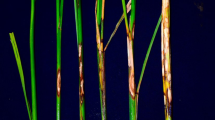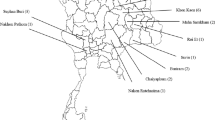Abstract
Sheath blight of rice caused by Rhizoctonia solani AG1IA is one of the devastating fungal diseases. One hundred and twelve R. solani AG1IA isolates collected from Uttar Pradesh, Uttarakhand and Haryana states of India were studied for their morphological characterization. All the isolates of R. solani AG1IA were classified into five groups on the basis of sclerotial arrangements i.e. Group-1, Group-2, Group-3, Group-4 and Group-5 which contains 28, 35, 44, 3 and 2 isolates, respectively. Majority of the isolates were spatial in growth pattern (38.3%), fast growing (40.1%), light brown colony colour (72.3%), scattered sclerotia (39.2%), deep dark brown sclerotia (91.0%), sclerotial clump formation (32.1%) and micro sized sclerotia (56.2%). The number of sclerotia produced was in the range of 3.7–10.7/5 mm mycelium disc. Two isolates RSV10 and RSJ79 did not produce any sclerotia. Time of initiation of sclerotia formation was varied between 4 and 6 days. Sixty-five isolates showed sclerotia formation on under surface of lid. Principal component analysis (PCA) of growth rate and number of sclerotia of R. solani AG1IA showed 100.00 and 86.84% variation, respectively. A field trial with 261 rice germplasm was conducted during the 2013–2014 and 2014–2015 Kharif seasons to screen the R. solani AG1IA resistant germplasm. Mean percent disease index (PDI) varied between 22.95 and 27.40%. On the basis of AUDPC (area under disease progress curve) values, rice germplasm lines belonged to 5 groups i.e. resistant, 57 (262.93–957.92), moderately resistant, 169 (957.93–1220.87), moderately susceptible, 14 (1220.88–1490.81), susceptible, 18 (1490.82–1753.75) and highly susceptible, 3 (1753.76–2016.69).





Similar content being viewed by others
References
Ahuja SC, Payak MM (1985) Comparative karyology, biology and pathology of maize and rice isolates of R. solani f. sp. sasakii. Indian Phytopathol 38:771–773
Banniza S, Sy AA, Bridge PD, Simons SA, Holderness M (1999) Characterization of populations of Rhizoctonia solani paddy rice fields in Cote d’ Ivoire. Phytopathology 89:414–420
Bonmann JM, Khush GS, Nelson RJ (1992) Breeding for resistance to pests. Annu Rev Phytopathol 30:507–523
Campbell CL, Madden LV (1990) Introduction to plant disease epidemiology. Wiley, New York, p 532
Chandra S, Singh HK, Kumar P, Yadav N (2016) Screening of rice (Oryza sativa L.) genotypes for sheath blight (Rhizoctonia solani) in changing climate scenario. J AgriSearch 3(2):130–132
Debbarma M, Dutta P (2015) Cultural and morphological variability in R. solani isolates of different hosts of Assam. Indian J Appl Res 5:878–883
Dubey AK, Pandian RTP, Rajashekara H, Khanna A, Ellur RK, Sharma P, Kumar A, Singh AK, Gopalakrishnan S, Rathour Ganeshamoorthi P, Dubey SC (2014) Morphological and pathogenic variability of R. solani isolates associated with wet root rot of chickpea in India. Legume Res 38:389–395
Goswami S, Thind TS, Kaur R, Kaur M (2012) Management of sheath blight of rice with novel actions fungicides. Indian Phytopathol 65(1):92–93
Goswami S, Singh V, Kashyap PL (2017) Population genetics structure of Rhizoctonia solani AG1IA from rice field in North India. Phytoparasitica 45:299–316
Groth DE, Novick EM (1992) Selection for resistance to sheath blight through the number of infection cushions and lesion type. Plant Dis 76:721–723
Guleria S, Aggarwal R, Thind TS, Sharma TR (2007) Morphological and pathological variability in rice isolates of Rhizoctonia solani and molecular analysis of their genetic variability. J Phytopathol 155:654–661
Hossain MK, Tze OS, Nadarajah K, Jena K, Bhuiyan MAR, Ratnam W (2014) Identification and validation of sheath blight resistance in rice (Oryza sativa L.) cultivars against Rhizoctonia solani. Can J Plant Pathol 36:482–490
IRRI (2002) Standard evaluation system for rice: reference guide. International Rice Research Institute, Los Banos
Jayaprakashvel M, Mathivanan N (2012) Morphological and pathological variation of rice sheath blight inciting south Indian Rhizoctonia solani isolates. Arch Phytopathol Plant Protoc 45(4):455–467
Jia L, Yan W, Zhu C, Agrama HA, Jackson A, Yeater K, Li X, Wu BD (2012) Allelic analysis of sheath blight resistance with association mapping in the rice. PLoS One 7(3):e32703
Johnson DA, Wilcoxson RD (1982) A table of areas under disease progress curves. Tech. Bull. Texas Agricultural Experiment Station, pp 80
Kalpana K, Maruthasalam S, Rajesh T, Kumar P, Kokila KK, Devi E, Jaj Raja, Sudhakar D, Velazhahan R, Samiyappan R, Balasubramanian P (2006) Engineering sheath blight resistance in elite indica rice cultivars using genes encoding defense proteins. Plant Sci 170:203–215
Kuiry SP, Mondal A, Banerjee S, Dutta S (2014) Morphological variability in Rhizoctonia solani isolates from different agro-ecological zones of West Bengal. Indian Arch Phytopathol Plant Protoc 47(6):728–736
Kumar M, Singh V, Singh N, Vikram P (2008) Morphological and virulence characterization of Rhizoctonia solani causing sheath blight of rice. Environ Ecol 26(3):1158–1166
Kumar S, Dwivedi SK, Kumar R, Bhakta N, Prakash V, Rao KK, Kumar R, Yadav S, Choubey AK, Mishra JS (2017) Screening of different rice germplasm against multiple disease under submergence condition in middle Indo Gangetic Plain. Int J Curr Microbiol Appl Sci 6(5):335–339
Li L, Zhang Q, Huang D (2014) A review of imaging techniques for plant phenotyping. Sensor 14:20078–20111
Linde CC, Zala M, Paulraj RSD, McDonald BA, Gnanamanickam SS (2005) Population structure of the rice sheath blight pathogen Rhizoctonia solani AG1IA from India. Eur J Plant Pathol 112:113–121
Lore JS, Hunjan MS, Goel RK, Singh K, Bharaj TS (2011) Sources of resistance to sheath blight disease of rice caused by Rhizoctonia solani Kühn. Indian Phytopathol 64(1):85–86
Lore JS, Jain J, Hunjan MS, Gargass G, Mangat GS, Sandhu JS (2015) Virulence spectrum and genetic structure of Rhizoctonia isolates associated with rice sheath blight in the northern region of India. Eur J Plant Pathol 143:847–860
Matsumoto M (2002) Trials of direct detection and identification of Rhizoctonia solani AG1 and AG2 subgroups using specifically primed PCR analysis. Mycoscience 43:185–189
Meena B, Ramamoorthy V, Muthusamy M (2001) Morphological and pathological variations in isolates of Rhizoctonia solani causing sheath blight of rice. Plant Dis Res 16:166–172
Meena SC, Singh V, Adhipathi P, Chand R (2013) Screening for sheath blight resistant genotypes among mutated populations of rice cv. Pusa Basmati-1. Bioscan 8(3):919–924
Meyer RW (1965). Heterokaryosis and nuclear phenomena in R. solani. Ph.D. thesis, Berkeley University of California, pp 118
Mishra PK, Gogoi R, Singh PK, Rai SN, Gingode A, Kumar A, Manjunathan C (2014) Morpho-cultural and pathogenic variability in Rhizoctonia solani isolates from rice, maize and green gram. Indian Phytopathol 67(2):147–154
Nadarajah K, Omar NS, Rosli MM, Tze OS (2014) Molecular characterization and screening for sheath blight resistance using Malaysian isolates of Rhizoctonia solani. BioMed Res Int. https://doi.org/10.1155/2014/434257 (Article ID 434257)
Neeraja CN, Vijayabhanu N, Shenoy VV, Reddy CS, Sharma NP (2002) RAPD analysis of Indian isolates of rice sheath blight fungus Rhizoctonia solani. J Plant Biochem Biotechnol 11:43–48
Prasad B, Eizenga GC (2008) Rice sheath blight disease resistance identified in Oryza species accessions. Plant Dis 92:1503–1509
Sha XY, Zhu LH (1990) Resistance of some rice varieties to sheath blight (ShB). Int Rice Res Newsl 15:7–8
Shamim MD, Kumar D, Srivastava D, Pandey P, Singh KN (2014) Evaluation of major cereal crops for resistance against Rhizoctonia solani under greenhouse and field conditions. Indian Phytopathol 67(1):2–6
Shaner G, Finney RE (1977) The effect of nitrogen fertilization on the expression of slow-mildewing resistance in ‘Knox’ wheat. Phytopathology 67:1051–1056
Sharma NR, Teng PS, Oliver FM (1990) Comparisons of assessment methods for rice sheath blight disease. Philipp Phytopathol 26:20–24
Sharma M, Gupta SK, Sharma TR (2005) Characterization of variability in Rhizoctonia solani by using morphological and molecular markers. J Phytopathol 153:449–456
Singh J, Singh RS (1994) Variability in cultural characteristics of Rhizoctonia solani isolates from black scurf of potato. Plant Dis Res 9:61–65
Singh A, Singh US, Willocquat L, Savary S, Singh A (1999) Relationship among cultural/morphological characteristics, anastomosis behavior and pathogenicity of Rhizoctonia solani Kuhn on rice. J Mycol Plant Pathol 29:306–316
Singh A, Rohilla R, Singh US, Savary S, Willocquet L, Duveiller E (2002a) An improved inoculation technique for sheath blight of rice caused by Rhizoctonia solani. Can J Plant Pathol 24:65–68
Singh V, Singh US, Singh KP, Singh M, Kumar A (2002b) Genetic diversity of Rhizoctonia solani by morphological characteristics, pathogenicity, anastomosis behaviour and RAPD fingerprinting. J Mycol Plant Pathol 32(3):332–344
Singh R, Murti S, Mehilalm Tomar A, Prasad D (2015) Virulence diversity in R. solani causing sheath blight of rice. J Plant Pathol Microbiol 6:296
Slaton NA, Cartwright RD, Meng J, Gbur EE Jr, Normann RJ (2003) Sheath blight severity and rice yield as affected by nitrogen rate, application method, and fungicide. Agron J 95:1489–1496
Sriram S, Raguchander T, Vidhyasekaran P, Muthukrishnan S, Samiyappan R (1997) Genetic relatedness with special reference to virulence among the isolates of Rhizoctonia solani causing sheath blight in rice. J Plant Dis Protoc 104:260–271
Susheela K, Reddy CS (2013) Variability in Rhizoctonia solani (AG1IA) isolates causing sheath blight of rice in India. Indian Phytopathol 66(4):341–350
Thakur RS, Sugha SK, Sharma BM (1992) Morphological grouping of different isolates of Rhizoctonia solani Kuhn. Plant Dis Res 7:58–59
Turaidar V, Krupa KN, Reddy M, Deepak CA, Harini KKM, Subhash BS (2017) Phenotyping of rice landraces for sheath blight resistance. J Pharmacogn Phytochem 6(5):2209–2212
Upmanyu S, Paul YS (2013) Cultural, morphological and physiological variations among different anastomosis groups of Rhizoctonia solani Kuhn in Himachal Pradesh. Plant Dis Res 28(2):113–120
Wheeler BEJ (1969) An Introduction to Plant Diseases. John Wiley and Sons Limited, London, p 301
Xing XL, Ping L, AiPing Z (2013) In vitro selection of sheath blight resistance germplasm in rice. Afr J Microbiol Res 7(35):4422–4429
Acknowledgements
The authors are thankful to the Head, Department of Mycology and Plant Pathology, Institute of Agricultural Sciences, Banaras Hindu University, Varanasi, Uttar Pradesh, India for supporting this work.
Author information
Authors and Affiliations
Corresponding author
Electronic supplementary material
Below is the link to the electronic supplementary material.
Rights and permissions
About this article
Cite this article
Goswami, S.K., Singh, V., Kashyap, P.L. et al. Morphological characterization and screening for sheath blight resistance using Indian isolates of Rhizoctonia solani AG1IA. Indian Phytopathology 72, 107–124 (2019). https://doi.org/10.1007/s42360-018-0103-2
Received:
Revised:
Accepted:
Published:
Issue Date:
DOI: https://doi.org/10.1007/s42360-018-0103-2




